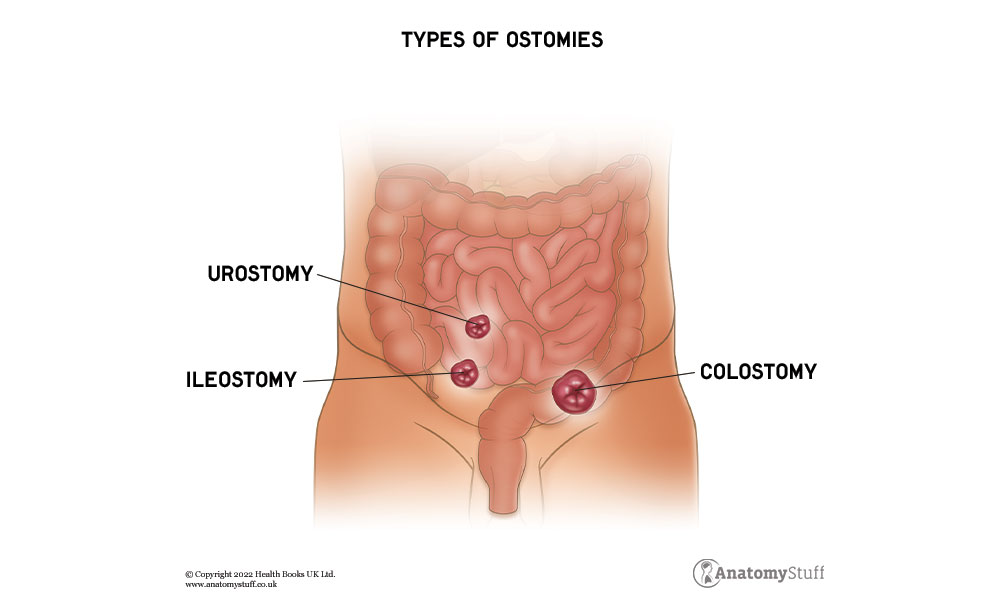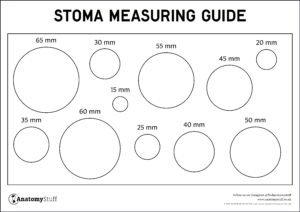Written by: Anne Marie Forgarty, RGN
Ostomy Care
An ostomy is a surgically created opening (stoma) from an area inside the body to the outside. A stoma is a result of an ostomy operation. It is an artificial opening that allows faeces or urine from the intestine or the urinary tract to pass out of the body. An ostomy pouch is essential to collect the output from the stoma. Carrying out effective ostomy care by cleaning the site, assessing the site for signs of infection, and monitoring output can help reduce and prevent infection after stoma surgery. A stoma may be created in different paths depending on the type of procedure required; however, in all procedures, a new pathway for waste materials is created.
For more information on ostomy anatomy, take a look at our ostomy anatomy chart.
Types of Ostomies
There are three major types of stomas: colostomy, ileostomy and urostomy.
A colostomy creates the opening into the colon through the abdomen. The objective is to bypass a certain portion of the colon that may be damaged or diseased. Colostomy surgery may be required for various medical reasons, such as cancers, Chron’s disease, or other reasons.
An ileostomy is performed when a portion of the patient’s small intestine and colon has been removed. This surgical procedure allows the waste to empty through an opening in the skin.
A urostomy is performed when a patient feels discomfort in naturally urinating. Tubes are connected to carry urine to the stoma, and patients with damaged bladders undergo this procedure.
Pre-surgery Guidelines
Before the surgery, the surgeon determines the need for the procedure, and the patient meets with the medical team to discuss the details. The healthcare team provides detailed insights regarding different ostomy procedures. The location of the stoma is determined based on the patient’s lifestyle and clothing preferences. Care guidelines for stomas are provided as well.
What happens during the surgery?
During the surgery, the patient is administered general anaesthesia.
The surgeons have two options:
1. Perform a long incision in the abdomen
2. Perform the procedure laparoscopically
Laparoscopy is the preferred option because it facilitates quicker patient recovery and greater precision. The type of incision is decided before the surgery commences. In a colostomy, the surgeons remove the damaged part of the rectum and attach a colostomy bag which is pouched in the stomach. In an ileostomy, the lower part of the small intestine is attached to the abdominal wall, and the ileostomy bag is pouched to the stoma. In urostomy, the surgeons modify the urinary tract by relocating the end of the small bowel. On relocation, the small bowel creates a passageway allowing urine to pass through the kidneys.
What happens after surgery?
Patients are hospitalised after the surgery, usually, the stay is short, ranging from a few hours to two days. The medical team checks on the patient to monitor healing and the functioning of the pouch. Intravenous drips are required for proper hydration. Patients can suffer from diarrhoea, hernia, prolapse, skin irritation, bleeding, infection, electrolytic imbalances, phantom rectum syndrome, rectal discharges, and vitamin B12 deficiency after surgery.
Recovery and Post-Operative Care
A patient’s full recovery can take up to 8 weeks. During this period, the patient’s movement is restricted, and activity is limited. The patient, however, should stay mobile as this aids healing and prevents infections. People who undergo the procedure wear an ostomy bag.
Most bags have two parts:
1. A barrier for protecting stoma
2. A disposable plastic bag
The bag needs to be replaced as per medical advice. Some bags are to be replaced daily, others every few days.
To prevent infection, the patient needs to wipe away any mucous found around the stoma; lukewarm water and mild soap must be used to clean the skin. Once the skin is rinsed, the area should be dried completely. Encourage the patient to self-examine the stoma to ensure they become familiar with how it looks. Any noticeable changes in the size, colour and shape need to be immediately reported to the healthcare team. Additionally, doctors must be contacted if the patient suffers from excessive bleeding, odour changes, skin irritation, or water discharge from the stoma lasting more than 6 hours. Patients can easily care for and manage stomas at home.
Assessment
Assess the stoma site for colour, drainage, and excoriation (signs of infection, redness, or oozing). Assess for adhesive and latex allergies. Peri-stomal skin assessment should be documented.
Patient Education
• Explain the procedure to the patient.
• Explain the stoma should be a red colour.
• Ensure patient dignity and privacy are upheld using bed screens and a respectful approach.
• Encourage and teach self-care of the stoma using a patient-centred holistic approach.
Ostomy Care Procedure
• Confirm patient identity and obtain consent.
• Wash your hands; dry well, and apply clean gloves.
• Cover the patient as much as possible for their privacy.
• Using adhesive remover, slowly peel the pouch off the skin with one hand while putting gentle pressure on the skin with the other.
• Dispose of the old pouch/bag in the clinical waste bag.
• Clean the stoma with lukewarm water and gauze (do not use soaps or baby wipes as they can leave an oily residue).
• Pat the skin dry with soft dry gauze. This is essential to obtain a good adhesive seal and prevent yeast infections.
• Place barrier cream around the site.
Measuring the Stoma
Stoma measurement is required to ensure a good fit of the pouch, reducing the risk of leakage and protecting the surrounding skin.
Equipment:
• Paper or card
• Scissors
• Measuring guide (click to download a free PDF)
Measuring Process
• Take a piece of card, place it over the stoma, and cut out a template.
• Use the template to cut the adhesive part of the pouch to size.
• Measure about 0.63 cm (¼ inch) larger than the actual stoma for the bag/appliance to fit.
• Cut the appliance as per the measuring sheet.
• Remove backing paper from the pouch and apply the clean pouch to the stoma.
• Apply the lower part beneath the stoma and roll up over the stoma. Hold in place for 30 seconds to ensure the pouch is secure. Ensure no wrinkles are present.
• Dispose of all appliances as per clinical waste disposal policy and wash your hands.
• Time and date when the new bag went on and initial it.
• The bag lies to the front on mobile patients and on the side if on bed rest.
• Document the procedure, date and time. Record the measurement size of the stoma and characteristics of the stoma.
Complications
Potential stoma complications include poor siting, hernia, prolapse, ischaemia/necrosis, and peristomal skin problems, including infection, necrosis, retraction, and pyoderma gangrenosum. So proper cleaning, observation and regular visits to stoma care nurses can all help reduce potential complications happening.
Caring for a patient with a new stoma requires excellent communication skills, empathy, and good nursing skills. Stoma care is essential to avoid complications such as above, and good care leads to good outcomes generally.
Related products
View All














